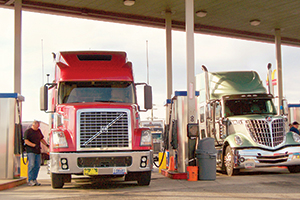Senior Reporter
Diesel Average Slides 4.1¢ to $2.338 in Fifth Straight Weekly Decline

The U.S. retail diesel average fell 4.1 cents a gallon to $2.338, the fifth consecutive decline, leaving diesel at its lowest in nearly 6½ years, the Department of Energy reported.
Trucking’s main fuel is $1.081 a gallon cheaper than a year ago. The current price is the lowest since it was $2.354 a gallon on June 1, 2009, DOE said after its Dec. 16 survey of fueling stations.
Diesel has fallen 14.4 cents a gallon in its five-week slide beginning Nov. 16. Prices fell in all regions, with New England’s 6.2-cent decline being the steepest.
“Temperatures in the upper Midwest and Northeast, where heating oil is used to heat homes, are expected to be much above normal through the end of December. The lack of demand for heating oil helped push ultra-low-sulfur diesel prices down again,” said Stephen Sly, president of risk management company Stabilitas Energy Inc.
DOE’s Energy Information Administration also said the national average price of gasoline fell 1.6 cents to $2.037 a gallon as prices dropped in all regions. The price is lowest in the Rocky Mountain region at $1.995.
Gasoline is 51.7 cents a gallon cheaper than a year ago, when the price was $2.554. It has fallen four weeks in a row.
Low fuel prices are influencing shippers’ selection of carriers, an analyst said.
“Shippers seem to be choosing capacity over cost savings, especially when it comes to their core carrier base,” Jonathan Starks, chief operating officer at research firm FTR, said in a statement. “This is a relatively easy choice given the downward-moving fuel markets. The easy fuel comparisons are expected to change in 2016, and that will make it more difficult for shippers to be as lenient on truckers’ base rates.”
Starks told Transport Topics, “I don’t see a significant rise [in diesel prices], just that they are likely to move higher than they are right now.”
He added,“Shippers will no longer be seeing big drops in fuel costs, and the current low prices are likely baked into their budgets and plans for 2016. It’s much easier to give a rate raise to a carrier when your all-in costs are still down versus your budget and the prior year.”
Separately, a report released last week found that proper truck maintenance can offer significant fuel savings.
That was the key finding in the North American Council for Freight Efficiency’s latest Trucking Efficiency Confidence Report covering maintenance.
“Adding up all of the potential reductions in fuel economy covered under the 10 components described in the report shows that maintenance can in fact address 30% to 50% of fuel consumption,” NACFE said.
Allie Sharp-Schwalb, CEO of the Nashville, Tennessee-based truckload carrier Sharp Transport, told TT that negotiating skills with fuel vendors, incentive pay and aerodynamic components on trailers were central to her management of fuel costs.
Sharp has about 100 trucks and buys about 25,000 gallons of fuel a week.
She said the fleet in 2014 tested an International ProStar equipped with “anti-drag” features, and the driver “pushed 10 miles a gallon on a trip to California.”
The carrier has since added ProStars to its fleet, she said.
Good drivers who grade high on a driver scorecard are rewarded with an extra 2 cents a mile, Sharp-Schwalb said. “We have a 30-year veteran here who, when we rolled it out, his comment was, ‘You hit it out of the ballpark this time.’ ”
On the New York Mercantile Exchange, crude oil settled at $36.31 a barrel Dec. 14, down from $37.68 a week earlier. The contract touched $34.53 during the week, the lowest price since February 2009, Bloomberg News reported.
Prices fell on remarks from an Iranian oil official who said there’s “absolutely no chance” his country will delay its plan to boost shipments, even as prices slip, Bloomberg said.
The International Energy Agency, which represents 29 countries including the United States, said in a release that global inventories are set to keep building at least until late 2016,“but at a much slower pace than observed this year.”




